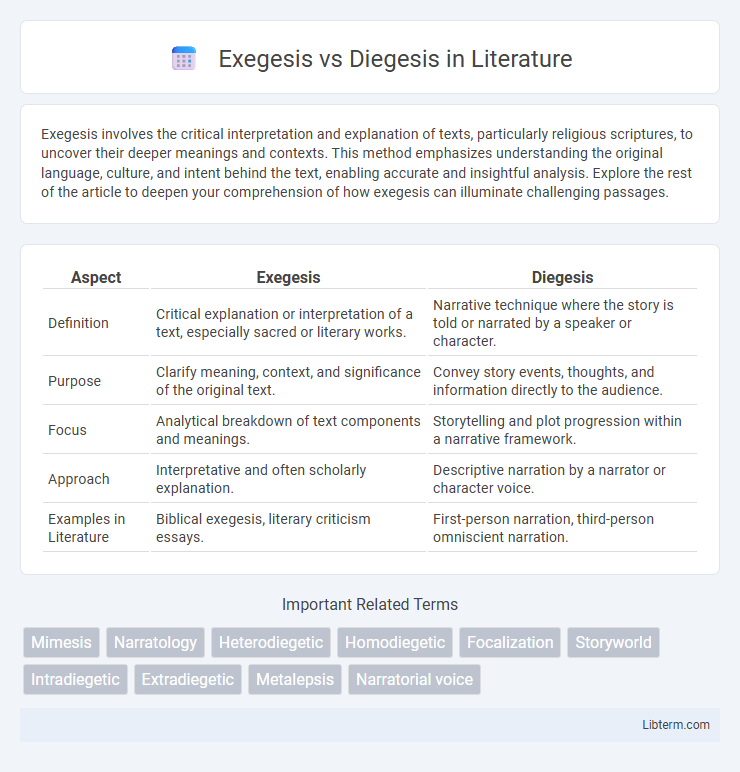Exegesis involves the critical interpretation and explanation of texts, particularly religious scriptures, to uncover their deeper meanings and contexts. This method emphasizes understanding the original language, culture, and intent behind the text, enabling accurate and insightful analysis. Explore the rest of the article to deepen your comprehension of how exegesis can illuminate challenging passages.
Table of Comparison
| Aspect | Exegesis | Diegesis |
|---|---|---|
| Definition | Critical explanation or interpretation of a text, especially sacred or literary works. | Narrative technique where the story is told or narrated by a speaker or character. |
| Purpose | Clarify meaning, context, and significance of the original text. | Convey story events, thoughts, and information directly to the audience. |
| Focus | Analytical breakdown of text components and meanings. | Storytelling and plot progression within a narrative framework. |
| Approach | Interpretative and often scholarly explanation. | Descriptive narration by a narrator or character voice. |
| Examples in Literature | Biblical exegesis, literary criticism essays. | First-person narration, third-person omniscient narration. |
Understanding Exegesis: Definition and Purpose
Exegesis involves critical interpretation and explanation of texts, primarily used to uncover deeper meanings within religious, literary, or philosophical works by analyzing context, language, and intended purpose. This method aims to clarify ambiguous passages and provide authoritative understanding based on historical and cultural backgrounds. By focusing on precise textual analysis, exegesis aids scholars and readers in grasping the original message and applying it appropriately in contemporary contexts.
The Nature of Diegesis in Narrative Theory
Diegesis in narrative theory refers to the internal world and events of a story as experienced by characters within its universe, encompassing all that constitutes the narrative's fictional reality. It contrasts with exegesis, which involves external interpretation and critical analysis beyond the story itself. Understanding diegesis helps clarify how narrative elements like setting, plot, and character perspectives are constructed to immerse the audience in the story's experiential realm.
Historical Origins of Exegesis and Diegesis
The historical origins of exegesis trace back to ancient religious and philosophical traditions, where scholars interpreted sacred texts to reveal deeper meanings and doctrinal truths. Diegesis emerged from early narratology and classical rhetoric, describing the narrative mode where a story is recounted by a narrator rather than shown through direct action. Both concepts evolved distinctly: exegesis rooted in hermeneutics and scriptural analysis, diegesis grounded in literary theory and storytelling techniques.
Key Differences Between Exegesis and Diegesis
Exegesis involves the critical interpretation and explanation of a text, primarily used in religious or literary contexts to uncover deeper meanings embedded within the original content. Diegesis refers to the narrative framework or world within a story, encompassing all events, characters, and settings as presented by the narrator. Key differences include exegesis as an analytical process applied externally to understand texts, while diegesis represents the storyteller's internal narrative reality.
Exegesis in Literature, Film, and Media
Exegesis in literature, film, and media involves the critical interpretation and explanation of texts, enabling a deeper understanding of underlying themes, symbols, and cultural contexts. It entails a methodical analysis of narrative elements, character motivations, and stylistic devices to reveal the author's or creator's intended message. This approach contrasts with diegesis by focusing on the interpretation and explication of content rather than the story world or narrative itself.
Diegesis: Storytelling From Within
Diegesis represents storytelling from within the narrative world, where the narrator directly recounts events, thoughts, and emotions, immersing the audience in the characters' experiences. Unlike exegesis, which interprets or explains a text from an external perspective, diegesis conveys the story through the internal logic and voice of the narrative itself. This technique enhances emotional engagement and allows for a deeper connection to the plot and characters by revealing their inner thoughts and motivations.
Practical Applications of Exegesis in Textual Analysis
Exegesis involves a critical and systematic interpretation of texts, particularly sacred or literary works, to uncover deeper meanings and contextual significance. It is widely applied in textual analysis to clarify ambiguous passages, ensure accurate comprehension of original intent, and guide informed scholarly or theological discussions. Practical uses include interpreting legal documents, religious scriptures, and classical literature, facilitating precise understanding and effective communication of complex ideas.
Diegetic vs. Non-Diegetic Elements in Narratives
Diegetic elements in narratives refer to sounds, objects, or events that exist within the story world and are perceived by characters, such as dialogue or background noises. Non-diegetic elements, like a film's soundtrack or voice-over narration, exist outside the story world and are intended only for the audience's understanding or emotional response. Understanding the distinction between diegetic and non-diegetic components is crucial for analyzing how narratives convey meaning and engage viewers through visual and auditory storytelling.
Intersections: When Exegesis Meets Diegesis
Exegesis involves critical interpretation and explanation of texts, often religious or literary, while diegesis refers to the narrative world and storytelling perspective within a text. Their intersection occurs when interpretive analysis (exegesis) delves into the narrative elements (diegesis), uncovering layers of meaning embedded in the story's structure, characters, and events. This fusion enhances understanding by bridging textual interpretation with immersive narrative experience, enriching both academic insight and reader engagement.
Exegesis vs. Diegesis: Implications for Modern Interpretation
Exegesis involves the critical explanation and interpretation of texts, emphasizing the original context and intended meaning, which supports accurate modern understanding. Diegesis refers to the narrative framework presented by the text, often shaping how stories are conveyed and received in contemporary media. The distinction between exegesis and diegesis influences modern interpretation by balancing analytical depth with narrative immersion, crucial for literary criticism, film analysis, and theological studies.
Exegesis Infographic

 libterm.com
libterm.com